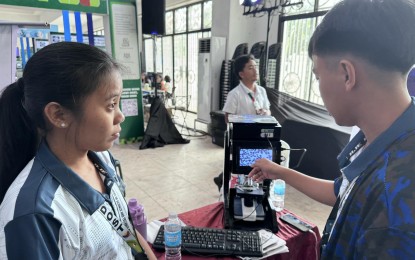
DETECTION. A sickle cell testing device developed by students from Eastern Samar State University. The technology will allow access to residents in remote areas of this blood disease detection service. (PNA photo by Florence R. Dableo, OJT)
TACLOBAN CITY – Students from Eastern Samar State University (ESSU) developed a ‘Sickle Cell Detection Device’ that will allow access to residents in remote areas of this blood disease detection service.
Student exhibitors Aubrey Balanay and Christian Casaba, both junior information technology students from the ESSU main campus in Borongan City, Eastern Samar, said on Thursday that they designed the technology to identify accurately the sickle cells from blood smears.
“This is intended for the remote areas to detect sickle cells because most remote areas cannot access hospital care. They have no means to acquire an immediate blood test,” Balanay said in an interview on Thursday.
The technology is among the exhibits during the 2024 Eastern Visayas Regional Science, Technology, and Innovation Week on June 25–27 at the People’s Center Library here.
Casaba said that among the interesting features of the sickle cell detection device is its ability to securely store data and transfer images to save and access results.
“This can store images using cloud storage. This can also allow the use of flash drives for transfers to save the results and images. This system will automatically identify sickle cells from blood smear images of patients. This can detect how many sickle cells we have,” he said.
Currently, the device is still for filing. The researchers are hopeful that, through exhibits, they will be able to solicit funding support for the patent application of this technology.
The World Health Organization (WHO) said sickle cell disease is a major genetic disease that affects many countries. In sickle cell disease, the normal round shape of red blood cells becomes like crescent moons.
Round red blood cells can move easily through the blood vessels, but sickled-shaped cells interconnect and can result in blood clots.
The blood clots, according to WHO, can cause extreme pain in the back, chest, hands, and feet. The disrupted blood flow can also cause damage to bones, muscles, and organs. People with sickle cell disease often feel weak, tired, and pale. The whites of the eyes and skin often have a yellowish tint. (With reports from Florence R. Dableo, OJT/PNA)
